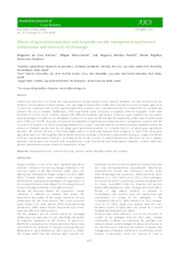Effects of agricultural practices and fungicides on the management postharvest anthracnose and stem-end rot of mango.
Effects of agricultural practices and fungicides on the management postharvest anthracnose and stem-end rot of mango.
Author(s): BATISTA, D. da C.; ALVES JÚNIOR, M.; PERUCH, L. A. M.; BARBOSA, M. A. G.
Summary: Anthracnose and stem-end rot are the main postharvest mango diseases in the Brazilian Northeast. In order to determine the incidence and prevalence of these diseases, near ripe (stage 3) Tommy Atkins fruits were collected from thirty orchards, aged 10 to 12 years old. Inspections and records regarding agricultural practices were undertaken in order to characterize the orchards and evaluate the risk of diseases. Additionally, three experiments were conducted to evaluate different fungicides. Fruits were harvested in Tommy Atkins orchards sprayed with different fungicides and disease incidences were evaluated for two weeks. General averages of incidence and prevalence of stem-end rot were 14.44% and 86.67% respectively, while those of anthracnose were 5.55% and 36.67%. Pearson?s chi-squared test identified a significant association between management practices and the occurrence of diseases. The risk of producing diseased fruits is larger in orchards that do not remove residues beneath or above the canopy or diseased panicles and do not adopt good agricultural practices. For orchards that do not adopt good agricultural practices, the relative risk was a 3.82 times higher chance of producing diseased fruits compared to those that adopt good agricultural practices. The fungicides that exhibited efficiency in disease control were pyraclostrobin (0.10 g/L), copper oxychloride (1.60 g/L) and tetraconazole (0.10 g/L). According to the results, in order to control anthracnose and stem-end rot in mangos, producers should spray the orchards with pyraclostrobin, copper oxychloride and tetraconazole fungicides, remove malformed panicles and diseased residues above and beneath the canopy
Publication year: 2023
Types of publication: Journal article
Unit: Embrapa Semi-arid Region
Keywords: Anthracnose, Antracnose, Análise de Risco, Botryosphaeriacea, Colletotrichum spp, Controle de doenças, Disease control, Doença de Planta, Fungicida, Manga, Mangifera Indica, Mangoes, Oxicloreto de cobre, Piraclostrobina, Plant diseases and disorders, Podridão Apical, Podridão do caule da manga, Postharvest diseases, Postharvest treatment, Pós-Colheita, Risk analysis, Tetraconazol, Tommy Atkins
Observation
Some of Embrapa's publications are published as ePub files. To read them, use or download one of the following free software options to your computer or mobile device. Android: Google Play Books; IOS: iBooks; Windows and Linux: Calibre.
Access other publications
Access the Agricultural Research Database (BDPA) to consult Embrapa's full library collection and records.
Visit Embrapa Bookstore to purchase books and other publications sold by Embrapa.

